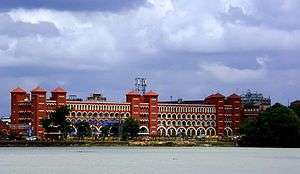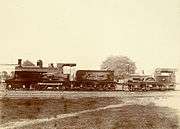Howrah Junction railway station
Howrah Junction | ||||||||||||||||
|---|---|---|---|---|---|---|---|---|---|---|---|---|---|---|---|---|
| Regional rail and Commuter rail station | ||||||||||||||||
 Howrah Station, view from Hooghly River | ||||||||||||||||
| Location |
Lower Foreshore Rd, Howrah - 711101 West Bengal India | |||||||||||||||
| Coordinates | 22°34′54″N 88°20′32″E / 22.5818°N 88.3423°ECoordinates: 22°34′54″N 88°20′32″E / 22.5818°N 88.3423°E | |||||||||||||||
| Elevation | 12 metres (39 ft) | |||||||||||||||
| Owned by | Indian Railways | |||||||||||||||
| Operated by | Eastern Railway and South Eastern Railway Zone | |||||||||||||||
| Line(s) |
Howrah-Delhi main line Howrah-Nagpur-Mumbai main line Howrah-Chennai main line Howrah-Allahabad-Mumbai main line | |||||||||||||||
| Platforms | 23 | |||||||||||||||
| Tracks | 25 | |||||||||||||||
| Connections |
| |||||||||||||||
| Construction | ||||||||||||||||
| Structure type | Standard (on ground station) | |||||||||||||||
| Parking | Available | |||||||||||||||
| Other information | ||||||||||||||||
| Status | Functioning | |||||||||||||||
| Station code | HWH | |||||||||||||||
| Division(s) | Howrah (ER) | |||||||||||||||
| History | ||||||||||||||||
| Opened | 1854 | |||||||||||||||
| Electrified | 1954[1] | |||||||||||||||
| Previous names | East Indian Railway Company | |||||||||||||||
| Services | ||||||||||||||||
| ||||||||||||||||
Howrah Junction (station code HWH), also known as Howrah Station, is the largest railway complex in India and it is a railway station which serves Kolkata and Howrah, India. Approximately 687 passenger trains pass through the station each day requiring its 23 platforms and serving more than 1 million passengers per day with a high train handling capacity. [2] Howrah Junction is one of five intercity railway stations serving the city of Kolkata, the others being Sealdah, Santragachi, Shalimar, and Kolkata railway station. The station is located in Howrah on the west bank of the Hooghly River.1373 stations across India are directly connected to Howrah Railway Station.
History
On 17 June 1851, George Turnbull, the Chief Engineer of the East Indian Railway Company submitted plans for a railway station at Howrah. In January 1852, the government authorities decided not to purchase the land and water frontage needed for the project. However, in May 1852, Turnbull was asked to render detailed plans for the station. The station's estimated cost was 250,000 rupees. In October 1852, four tenders for the building of the station were received. They varied from 190,000 to 274,526 rupees.[3][4]
In 1901, a new station building was proposed due to increased demand for rail travel. The British architect Halsey Ricardo designed the new station. It was opened to the public on 1 December 1905.[5] This is the current Howrah station building including 15 platform tracks.
In 1969, the first Rajdhani Express left Howrah Junction for New Delhi.
In the 1980s, the station was expanded including 8 new platform tracks on the south side of the station.On the other hand, the opening of the bridge over the Rupnarayan River at Kolaghat, on 19 April 1900, connected Howrah with Kharagpur. At the same time, a new Yatri Niwas (transit passenger facility) was built south of the original station frontage.
Until 1992, there was a tram terminus at Howrah station. Trams departed for Rajabazar, Sealdah Station, High Court, Dalhousie Square, Park Circus and Shyambazar. Trams also departed for Bandhaghat and Shibpur. The terminus was partially closed in 1971 while the Bandhaghat and Shibpur lines were closed. Many unauthorized vehicles and pedestrians began to traverse the tram tracks and so the routes were not continued. The terminus station was converted to underpasses and a bus terminus. The part of the tram terminus for other routes continued to function until 1992, when the Rabindra Setu (Howrah Bridge) was declared unfit to carry trams because it was a cantilever bridge.
In October 2011, India's first double-decker train left Howrah for Dhanbad.
North of the station there is a railway museum displaying artefacts of historical importance related to the development of Eastern Railway. For many years the Fairy Queen, the world's oldest operational steam locomotive, was displayed on a plinth inside the station.[6]
Rail services
The Eastern Railway runs local trains to Belur Math, Tarakeswar, Arambagh, Goghat, Katwa, Bandel, Sheoraphuli, Bardhaman, Serampore and numerous intermediate stations (see Main Line, Chord, and Tarakeswar branch line). There are also mail and express trains to Central, North and North-East India. A narrow gauge line connects Bardhaman and Katwa, served by DMU trains (all the other lines run EMU trains).
The South Eastern Railway, operates local trains to Amta, Mecheda, Panskura, Haldia, Tamluk, Kanthi, Medinipur and Kharagpur and mail and express trains to Central, West and South India. South Eastern Railway, connects with the Great Indian Peninsular Railway (GIPR) route to Mumbai and Chennai.
The Eastern Railway and South Eastern Railway sections are connected by two links. One is the Lilua–Tikiapara link, and the other is the Rajchandrapur–Dankuni-Maurigram link. They are used by goods trains and the Sealdah-Puri Duronto Express, avoiding Howrah.
Four major rail routes end in Howrah. They are the Howrah-Delhi, Howrah-Mumbai, Howrah-Chennai and Howrah-Guwahati routes.
After completion, Kolkata Metro Line 2 will pass through Howrah. It will be one of the deepest metro station in India and also first Underwater metro in India.
Station facilities
The station is the divisional headquarters for the Eastern Railway.
The station has 23 platforms. Platforms 1 to 15 are located in the old complex, referred to as "Terminal 1". It serves the local and long-distance trains of Eastern Railway and local trains of South Eastern Railway. Platforms 16 to 23 are in the new complex, referred to as "Terminal 2". It serves the long distance trains of South Eastern Railway.
There is a large covered waiting area between the main complex and the platforms and other areas for passengers awaiting connecting trains.Google provides RailWire Free high speed wifi. In addition, there is a transit passenger facility with dormitory, single room and double room accommodation. First class passengers wait in an air-conditioned area with balcony views of the Kolkata Skyline and the Howrah Bridge.
The station platforms have carriageways for motor vehicles within the complex including two carriageways to platforms 8 and 9 for Eastern Railway and to platforms 21 and 22 for South Eastern Railway. Flyovers at the ends of the platforms allow motor vehicles to exit the complex quickly.
Sampath Rail Yatri Niwas and Regional Rail Museum are a part of "Terminal 2" Howrah station complex.[7][8]
Services for rolling stock
The station has a diesel locomotive shed with room for 84 locomotives. The electric locomotive shed has room for 96 locomotives. There is also an electric trip shed with the capacity to hold up to 20 locomotives. The sheds accommodate 100 WAP-4 class locomotives. The EMU car shed has over fifteen parking slots. The station has a coach maintenance complex.
The South Eastern Railway's EMU car shed is at Tikiapara and there is an electric locomotive shed situated at Santragachhi. There is an Eastern Railways carriage and wagons workshop at Liluah.
Gallery
 EMU train bound for Howrah, 2011
EMU train bound for Howrah, 2011 Howrah station bus terminal.
Howrah station bus terminal. Howrah station
Howrah station The first locomotive, shown on the right and christened "multum in parvo" (barely visible on the wheel casing), which was used by the East Indian Railway Company in 1854 on its 23-mile line from Howrah to Pandua.
The first locomotive, shown on the right and christened "multum in parvo" (barely visible on the wheel casing), which was used by the East Indian Railway Company in 1854 on its 23-mile line from Howrah to Pandua. Yatri Nivas (Travellers' Lodge) at Howrah Station
Yatri Nivas (Travellers' Lodge) at Howrah Station- Double decker train arrives at Howrah Station after a trial run
 Howrah Railway Station area
Howrah Railway Station area Old steam locomotive at Howrah Junction
Old steam locomotive at Howrah Junction Old steam locomotive detail
Old steam locomotive detail Howrah Junction entrance
Howrah Junction entrance Howrah Junction platform
Howrah Junction platform
See also
References
- ↑ "[IRFCA] Indian Railways FAQ: Electric Traction - I". Irfca.org. Retrieved 2012-06-13.
- ↑ "Stations directly connected to Howrah Railway Station". IndianRailways.info. Retrieved 21 September 2016.
- ↑ Diaries of George Turnbull (Chief Engineer, East Indian Railway Company) held at the Centre of South Asian Studies at Cambridge University, England
- ↑ George Turnbull, C. E . pages 110, 121, 122, 125 and 127 of the 437-page memoirs published privately 1893, scanned copy held in the British Library, London on compact disk since 2007
- ↑ "Howrah Station is veritably the heartbeat of Kolkata". thehindubusinessline.com. The Hindu. 2005-12-02. Retrieved 2009-01-02.
- ↑ Ahrons, E.L. (1966). The British Steam Railway Locomotive. I, to 1925. Ian Allan. p. 142.
- ↑ "New visiting time for Howrah Rail Museum – RailNews Media India Ltd". www.railnews.in. Retrieved 2018-03-02.
- ↑ "IRFCA - The Indian Railways Fan Club Photo Gallery - Howrah Railway Museum". www.irfca.org. Retrieved 2018-03-02.
| Wikimedia Commons has media related to Howrah station. |
| Wikivoyage has a travel guide for Howrah. |